Accounting for Business: Financial Information Needs of External Users
VerifiedAdded on 2022/12/28
|9
|2395
|41
Report
AI Summary
This report delves into the crucial role of financial accounting in providing essential information to various stakeholders, particularly external users. It examines how financial statements cater to the specific needs of investors, regulatory agencies, trade creditors or suppliers, employees and trade unions, and customers, highlighting the significance of accurate and reliable data for informed decision-making. The report also explores the weaknesses that can arise from misrepresented financial information, emphasizing the potential consequences for each user group. Furthermore, it discusses the qualitative characteristics of accounting information, such as understandability, reliability, relevance, comparability, and timeliness, which are essential for ensuring the usefulness and credibility of financial reports. The conclusion underscores the importance of transparent and timely financial reporting for fostering trust and supporting effective business operations and decision-making across all stakeholder groups.
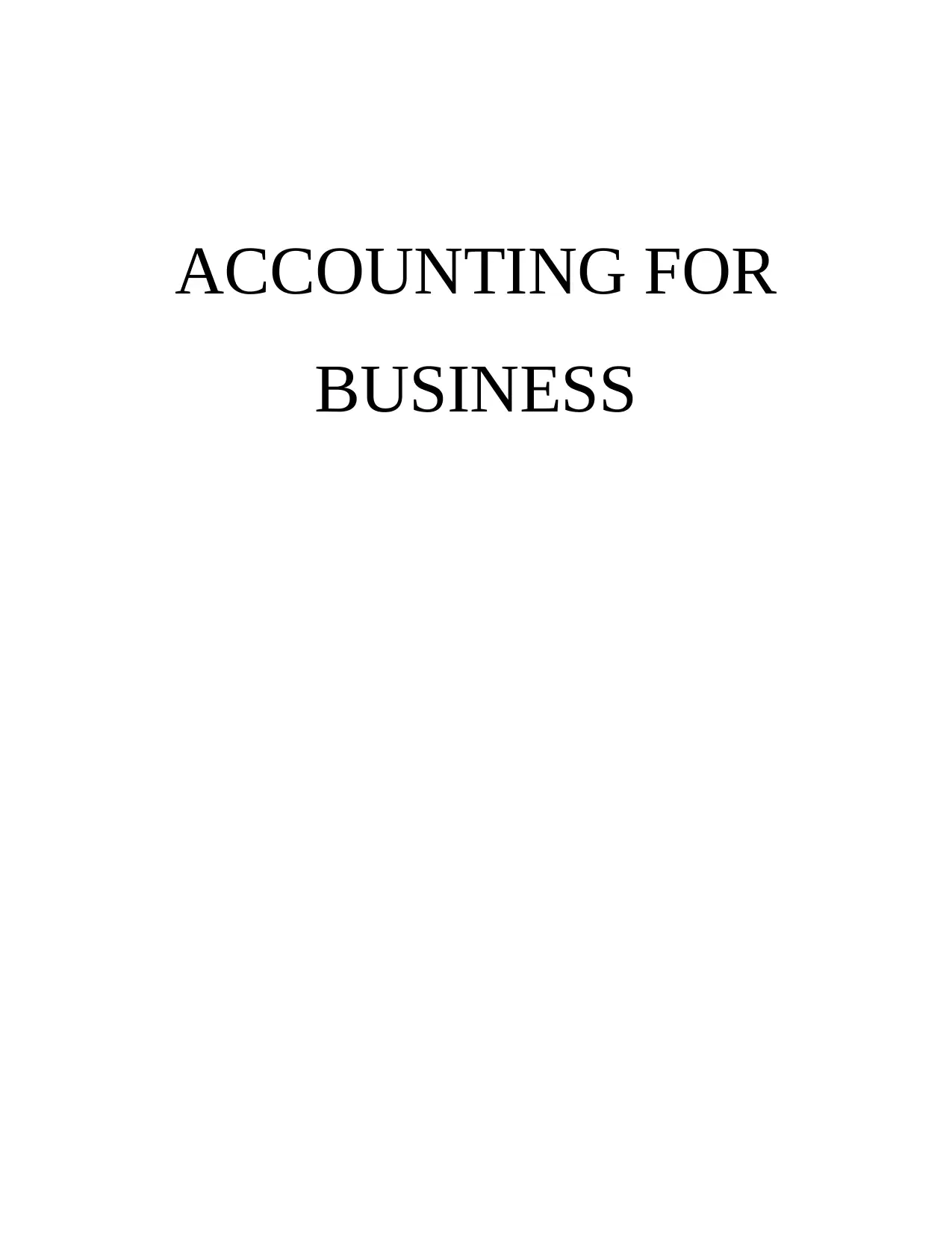
ACCOUNTING FOR
BUSINESS
BUSINESS
Paraphrase This Document
Need a fresh take? Get an instant paraphrase of this document with our AI Paraphraser
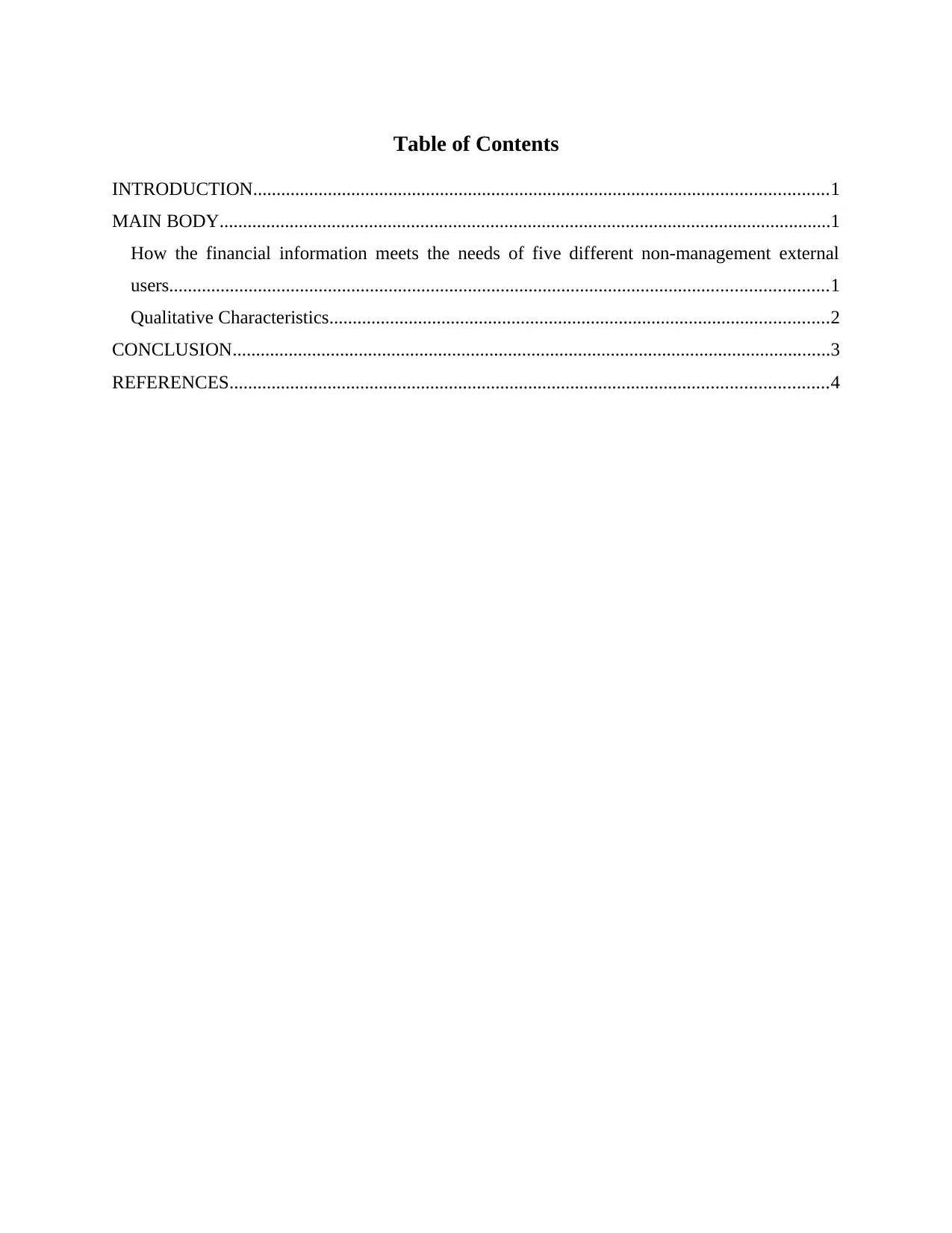
Table of Contents
INTRODUCTION...........................................................................................................................1
MAIN BODY...................................................................................................................................1
How the financial information meets the needs of five different non-management external
users.............................................................................................................................................1
Qualitative Characteristics...........................................................................................................2
CONCLUSION................................................................................................................................3
REFERENCES................................................................................................................................4
INTRODUCTION...........................................................................................................................1
MAIN BODY...................................................................................................................................1
How the financial information meets the needs of five different non-management external
users.............................................................................................................................................1
Qualitative Characteristics...........................................................................................................2
CONCLUSION................................................................................................................................3
REFERENCES................................................................................................................................4

⊘ This is a preview!⊘
Do you want full access?
Subscribe today to unlock all pages.

Trusted by 1+ million students worldwide
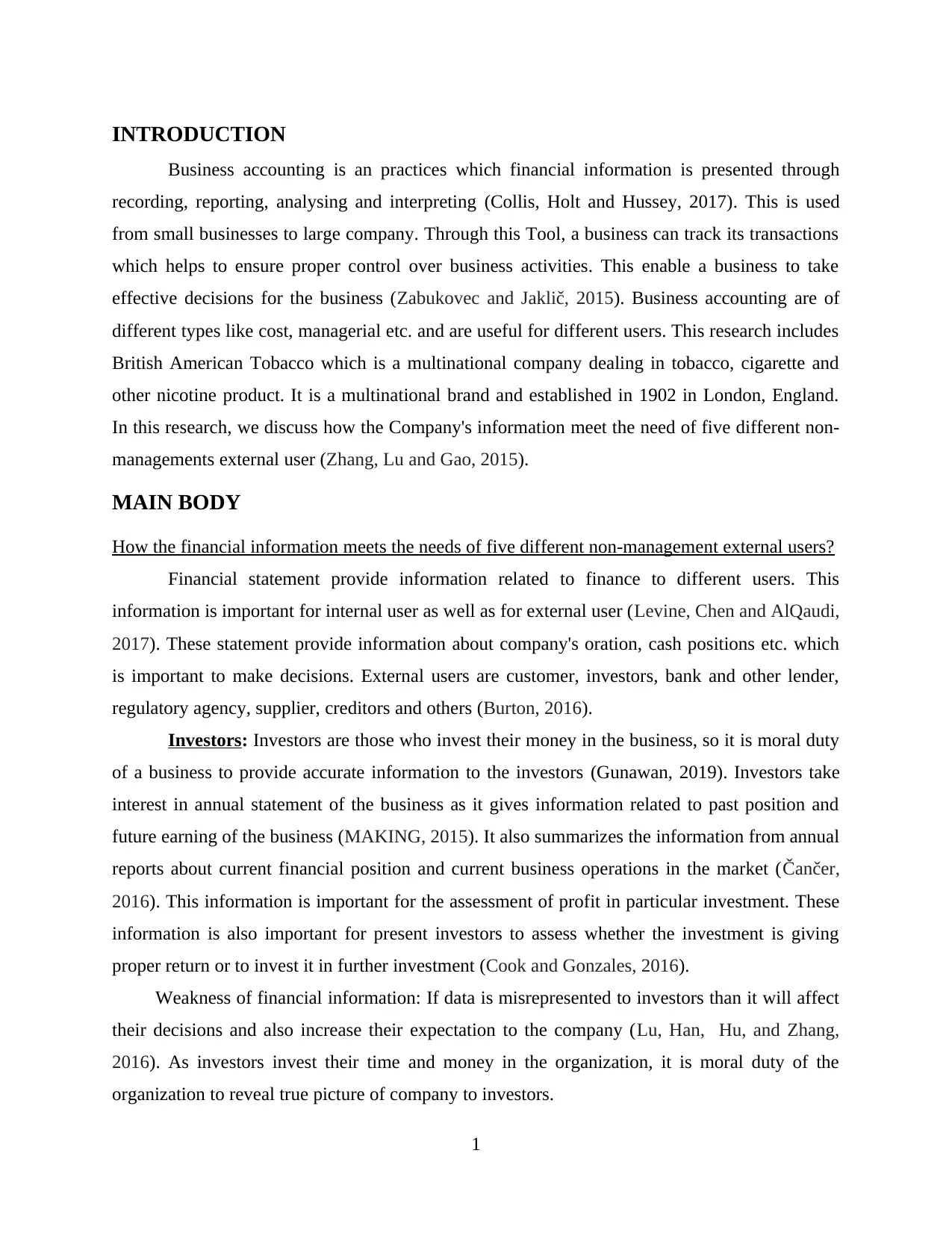
INTRODUCTION
Business accounting is an practices which financial information is presented through
recording, reporting, analysing and interpreting (Collis, Holt and Hussey, 2017). This is used
from small businesses to large company. Through this Tool, a business can track its transactions
which helps to ensure proper control over business activities. This enable a business to take
effective decisions for the business (Zabukovec and Jaklič, 2015). Business accounting are of
different types like cost, managerial etc. and are useful for different users. This research includes
British American Tobacco which is a multinational company dealing in tobacco, cigarette and
other nicotine product. It is a multinational brand and established in 1902 in London, England.
In this research, we discuss how the Company's information meet the need of five different non-
managements external user (Zhang, Lu and Gao, 2015).
MAIN BODY
How the financial information meets the needs of five different non-management external users?
Financial statement provide information related to finance to different users. This
information is important for internal user as well as for external user (Levine, Chen and AlQaudi,
2017). These statement provide information about company's oration, cash positions etc. which
is important to make decisions. External users are customer, investors, bank and other lender,
regulatory agency, supplier, creditors and others (Burton, 2016).
Investors: Investors are those who invest their money in the business, so it is moral duty
of a business to provide accurate information to the investors (Gunawan, 2019). Investors take
interest in annual statement of the business as it gives information related to past position and
future earning of the business (MAKING, 2015). It also summarizes the information from annual
reports about current financial position and current business operations in the market (Čančer,
2016). This information is important for the assessment of profit in particular investment. These
information is also important for present investors to assess whether the investment is giving
proper return or to invest it in further investment (Cook and Gonzales, 2016).
Weakness of financial information: If data is misrepresented to investors than it will affect
their decisions and also increase their expectation to the company (Lu, Han, Hu, and Zhang,
2016). As investors invest their time and money in the organization, it is moral duty of the
organization to reveal true picture of company to investors.
1
Business accounting is an practices which financial information is presented through
recording, reporting, analysing and interpreting (Collis, Holt and Hussey, 2017). This is used
from small businesses to large company. Through this Tool, a business can track its transactions
which helps to ensure proper control over business activities. This enable a business to take
effective decisions for the business (Zabukovec and Jaklič, 2015). Business accounting are of
different types like cost, managerial etc. and are useful for different users. This research includes
British American Tobacco which is a multinational company dealing in tobacco, cigarette and
other nicotine product. It is a multinational brand and established in 1902 in London, England.
In this research, we discuss how the Company's information meet the need of five different non-
managements external user (Zhang, Lu and Gao, 2015).
MAIN BODY
How the financial information meets the needs of five different non-management external users?
Financial statement provide information related to finance to different users. This
information is important for internal user as well as for external user (Levine, Chen and AlQaudi,
2017). These statement provide information about company's oration, cash positions etc. which
is important to make decisions. External users are customer, investors, bank and other lender,
regulatory agency, supplier, creditors and others (Burton, 2016).
Investors: Investors are those who invest their money in the business, so it is moral duty
of a business to provide accurate information to the investors (Gunawan, 2019). Investors take
interest in annual statement of the business as it gives information related to past position and
future earning of the business (MAKING, 2015). It also summarizes the information from annual
reports about current financial position and current business operations in the market (Čančer,
2016). This information is important for the assessment of profit in particular investment. These
information is also important for present investors to assess whether the investment is giving
proper return or to invest it in further investment (Cook and Gonzales, 2016).
Weakness of financial information: If data is misrepresented to investors than it will affect
their decisions and also increase their expectation to the company (Lu, Han, Hu, and Zhang,
2016). As investors invest their time and money in the organization, it is moral duty of the
organization to reveal true picture of company to investors.
1
Paraphrase This Document
Need a fresh take? Get an instant paraphrase of this document with our AI Paraphraser
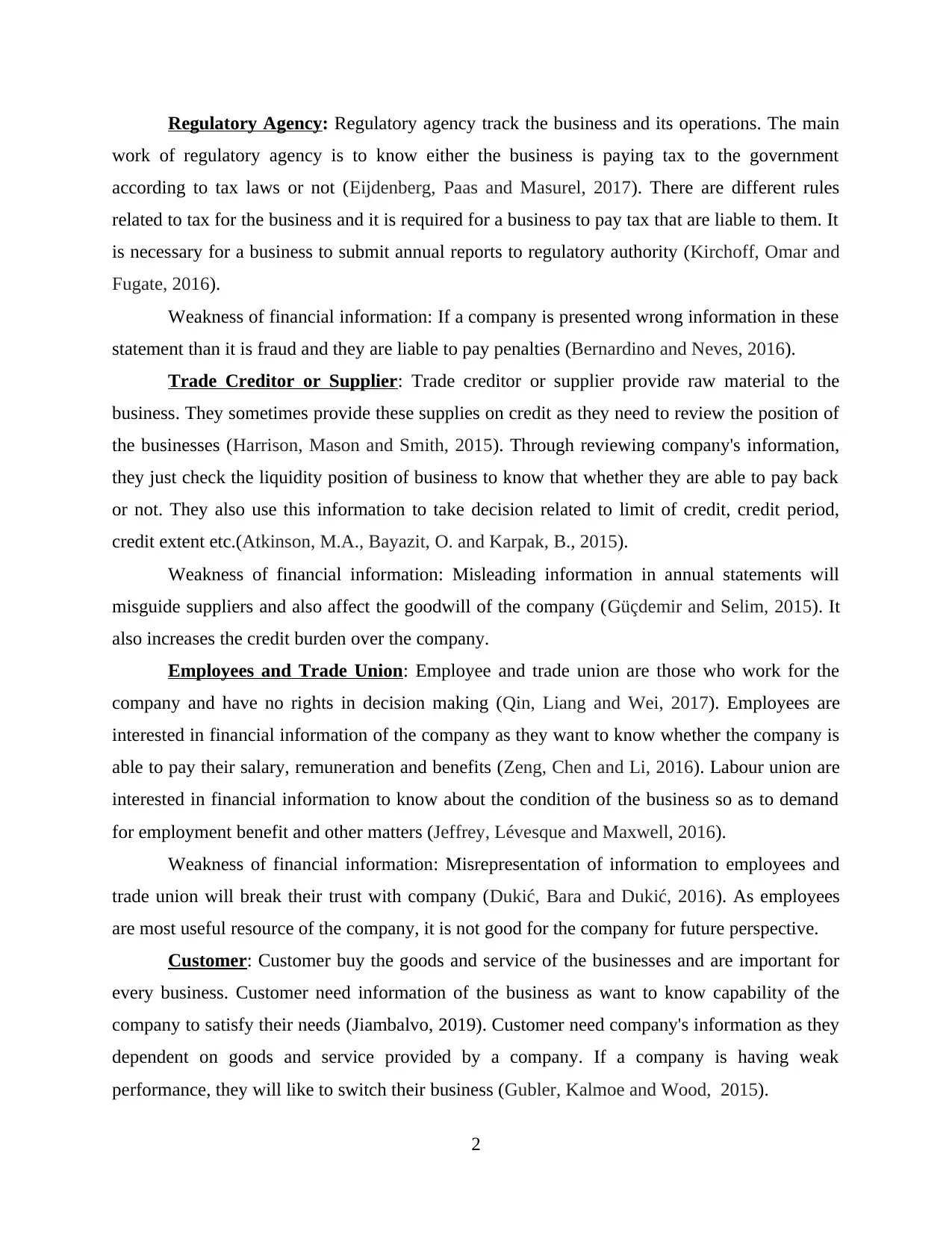
Regulatory Agency: Regulatory agency track the business and its operations. The main
work of regulatory agency is to know either the business is paying tax to the government
according to tax laws or not (Eijdenberg, Paas and Masurel, 2017). There are different rules
related to tax for the business and it is required for a business to pay tax that are liable to them. It
is necessary for a business to submit annual reports to regulatory authority (Kirchoff, Omar and
Fugate, 2016).
Weakness of financial information: If a company is presented wrong information in these
statement than it is fraud and they are liable to pay penalties (Bernardino and Neves, 2016).
Trade Creditor or Supplier: Trade creditor or supplier provide raw material to the
business. They sometimes provide these supplies on credit as they need to review the position of
the businesses (Harrison, Mason and Smith, 2015). Through reviewing company's information,
they just check the liquidity position of business to know that whether they are able to pay back
or not. They also use this information to take decision related to limit of credit, credit period,
credit extent etc.(Atkinson, M.A., Bayazit, O. and Karpak, B., 2015).
Weakness of financial information: Misleading information in annual statements will
misguide suppliers and also affect the goodwill of the company (Güçdemir and Selim, 2015). It
also increases the credit burden over the company.
Employees and Trade Union: Employee and trade union are those who work for the
company and have no rights in decision making (Qin, Liang and Wei, 2017). Employees are
interested in financial information of the company as they want to know whether the company is
able to pay their salary, remuneration and benefits (Zeng, Chen and Li, 2016). Labour union are
interested in financial information to know about the condition of the business so as to demand
for employment benefit and other matters (Jeffrey, Lévesque and Maxwell, 2016).
Weakness of financial information: Misrepresentation of information to employees and
trade union will break their trust with company (Dukić, Bara and Dukić, 2016). As employees
are most useful resource of the company, it is not good for the company for future perspective.
Customer: Customer buy the goods and service of the businesses and are important for
every business. Customer need information of the business as want to know capability of the
company to satisfy their needs (Jiambalvo, 2019). Customer need company's information as they
dependent on goods and service provided by a company. If a company is having weak
performance, they will like to switch their business (Gubler, Kalmoe and Wood, 2015).
2
work of regulatory agency is to know either the business is paying tax to the government
according to tax laws or not (Eijdenberg, Paas and Masurel, 2017). There are different rules
related to tax for the business and it is required for a business to pay tax that are liable to them. It
is necessary for a business to submit annual reports to regulatory authority (Kirchoff, Omar and
Fugate, 2016).
Weakness of financial information: If a company is presented wrong information in these
statement than it is fraud and they are liable to pay penalties (Bernardino and Neves, 2016).
Trade Creditor or Supplier: Trade creditor or supplier provide raw material to the
business. They sometimes provide these supplies on credit as they need to review the position of
the businesses (Harrison, Mason and Smith, 2015). Through reviewing company's information,
they just check the liquidity position of business to know that whether they are able to pay back
or not. They also use this information to take decision related to limit of credit, credit period,
credit extent etc.(Atkinson, M.A., Bayazit, O. and Karpak, B., 2015).
Weakness of financial information: Misleading information in annual statements will
misguide suppliers and also affect the goodwill of the company (Güçdemir and Selim, 2015). It
also increases the credit burden over the company.
Employees and Trade Union: Employee and trade union are those who work for the
company and have no rights in decision making (Qin, Liang and Wei, 2017). Employees are
interested in financial information of the company as they want to know whether the company is
able to pay their salary, remuneration and benefits (Zeng, Chen and Li, 2016). Labour union are
interested in financial information to know about the condition of the business so as to demand
for employment benefit and other matters (Jeffrey, Lévesque and Maxwell, 2016).
Weakness of financial information: Misrepresentation of information to employees and
trade union will break their trust with company (Dukić, Bara and Dukić, 2016). As employees
are most useful resource of the company, it is not good for the company for future perspective.
Customer: Customer buy the goods and service of the businesses and are important for
every business. Customer need information of the business as want to know capability of the
company to satisfy their needs (Jiambalvo, 2019). Customer need company's information as they
dependent on goods and service provided by a company. If a company is having weak
performance, they will like to switch their business (Gubler, Kalmoe and Wood, 2015).
2
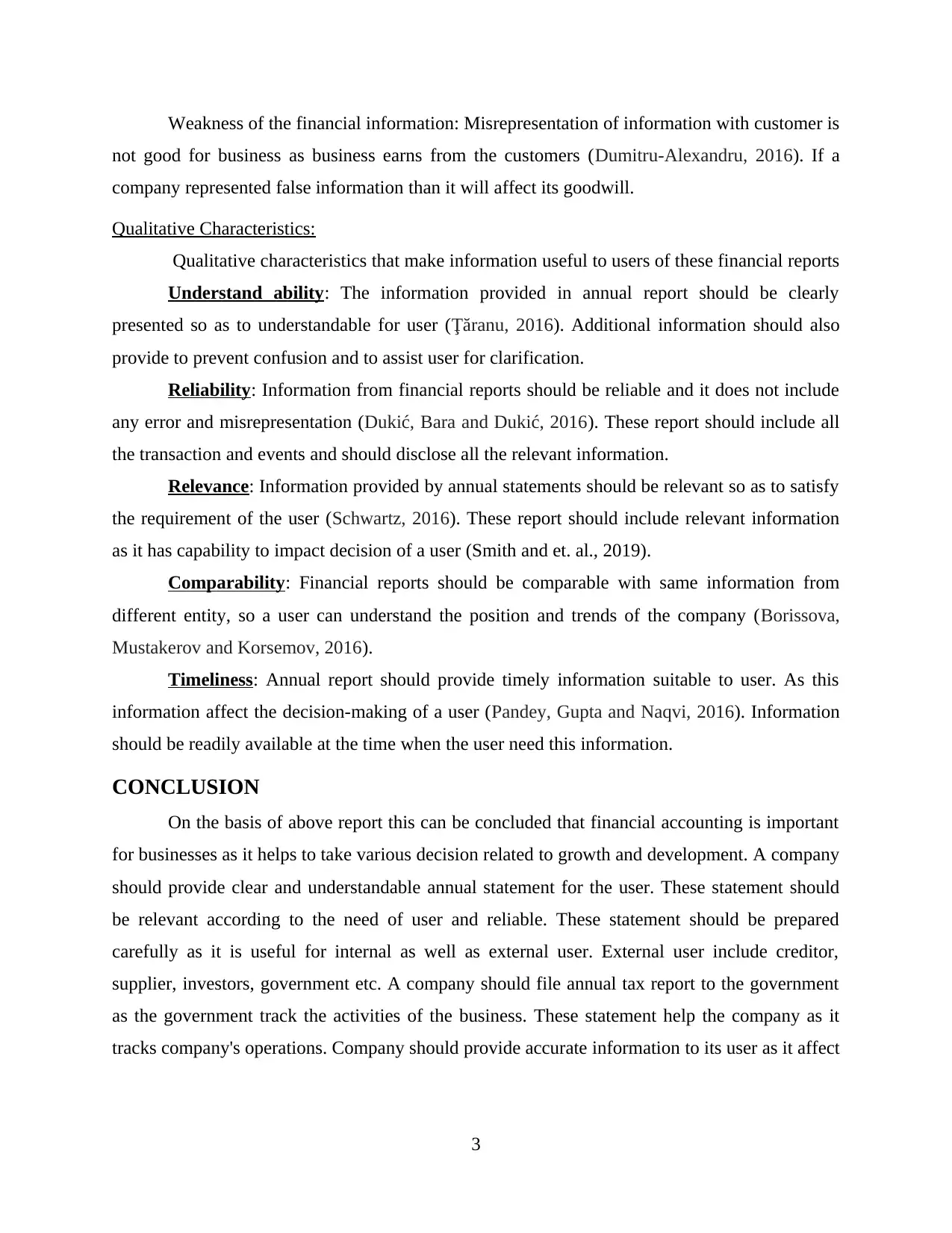
Weakness of the financial information: Misrepresentation of information with customer is
not good for business as business earns from the customers (Dumitru-Alexandru, 2016). If a
company represented false information than it will affect its goodwill.
Qualitative Characteristics:
Qualitative characteristics that make information useful to users of these financial reports
Understand ability: The information provided in annual report should be clearly
presented so as to understandable for user (Ţăranu, 2016). Additional information should also
provide to prevent confusion and to assist user for clarification.
Reliability: Information from financial reports should be reliable and it does not include
any error and misrepresentation (Dukić, Bara and Dukić, 2016). These report should include all
the transaction and events and should disclose all the relevant information.
Relevance: Information provided by annual statements should be relevant so as to satisfy
the requirement of the user (Schwartz, 2016). These report should include relevant information
as it has capability to impact decision of a user (Smith and et. al., 2019).
Comparability: Financial reports should be comparable with same information from
different entity, so a user can understand the position and trends of the company (Borissova,
Mustakerov and Korsemov, 2016).
Timeliness: Annual report should provide timely information suitable to user. As this
information affect the decision-making of a user (Pandey, Gupta and Naqvi, 2016). Information
should be readily available at the time when the user need this information.
CONCLUSION
On the basis of above report this can be concluded that financial accounting is important
for businesses as it helps to take various decision related to growth and development. A company
should provide clear and understandable annual statement for the user. These statement should
be relevant according to the need of user and reliable. These statement should be prepared
carefully as it is useful for internal as well as external user. External user include creditor,
supplier, investors, government etc. A company should file annual tax report to the government
as the government track the activities of the business. These statement help the company as it
tracks company's operations. Company should provide accurate information to its user as it affect
3
not good for business as business earns from the customers (Dumitru-Alexandru, 2016). If a
company represented false information than it will affect its goodwill.
Qualitative Characteristics:
Qualitative characteristics that make information useful to users of these financial reports
Understand ability: The information provided in annual report should be clearly
presented so as to understandable for user (Ţăranu, 2016). Additional information should also
provide to prevent confusion and to assist user for clarification.
Reliability: Information from financial reports should be reliable and it does not include
any error and misrepresentation (Dukić, Bara and Dukić, 2016). These report should include all
the transaction and events and should disclose all the relevant information.
Relevance: Information provided by annual statements should be relevant so as to satisfy
the requirement of the user (Schwartz, 2016). These report should include relevant information
as it has capability to impact decision of a user (Smith and et. al., 2019).
Comparability: Financial reports should be comparable with same information from
different entity, so a user can understand the position and trends of the company (Borissova,
Mustakerov and Korsemov, 2016).
Timeliness: Annual report should provide timely information suitable to user. As this
information affect the decision-making of a user (Pandey, Gupta and Naqvi, 2016). Information
should be readily available at the time when the user need this information.
CONCLUSION
On the basis of above report this can be concluded that financial accounting is important
for businesses as it helps to take various decision related to growth and development. A company
should provide clear and understandable annual statement for the user. These statement should
be relevant according to the need of user and reliable. These statement should be prepared
carefully as it is useful for internal as well as external user. External user include creditor,
supplier, investors, government etc. A company should file annual tax report to the government
as the government track the activities of the business. These statement help the company as it
tracks company's operations. Company should provide accurate information to its user as it affect
3
⊘ This is a preview!⊘
Do you want full access?
Subscribe today to unlock all pages.

Trusted by 1+ million students worldwide
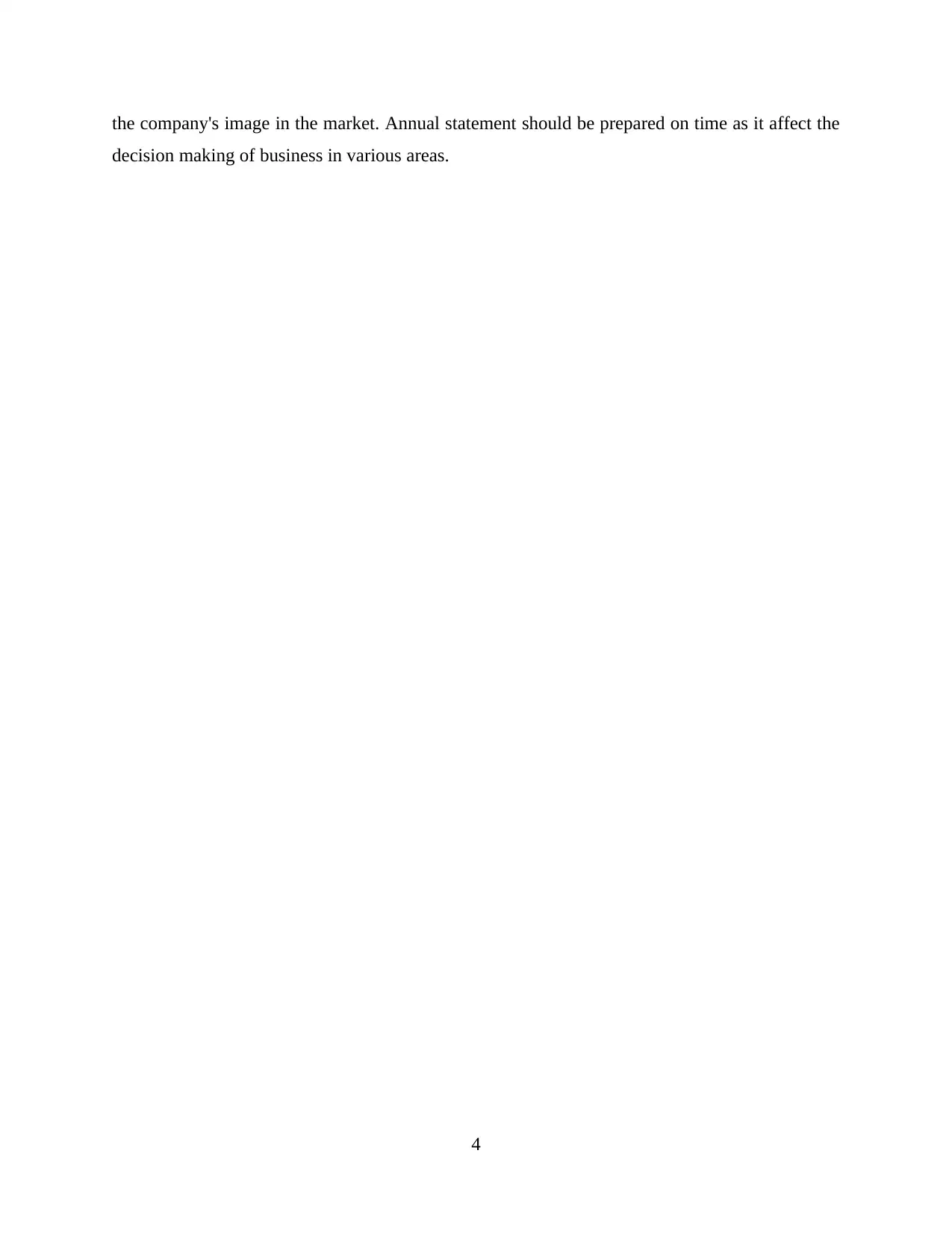
the company's image in the market. Annual statement should be prepared on time as it affect the
decision making of business in various areas.
4
decision making of business in various areas.
4
Paraphrase This Document
Need a fresh take? Get an instant paraphrase of this document with our AI Paraphraser
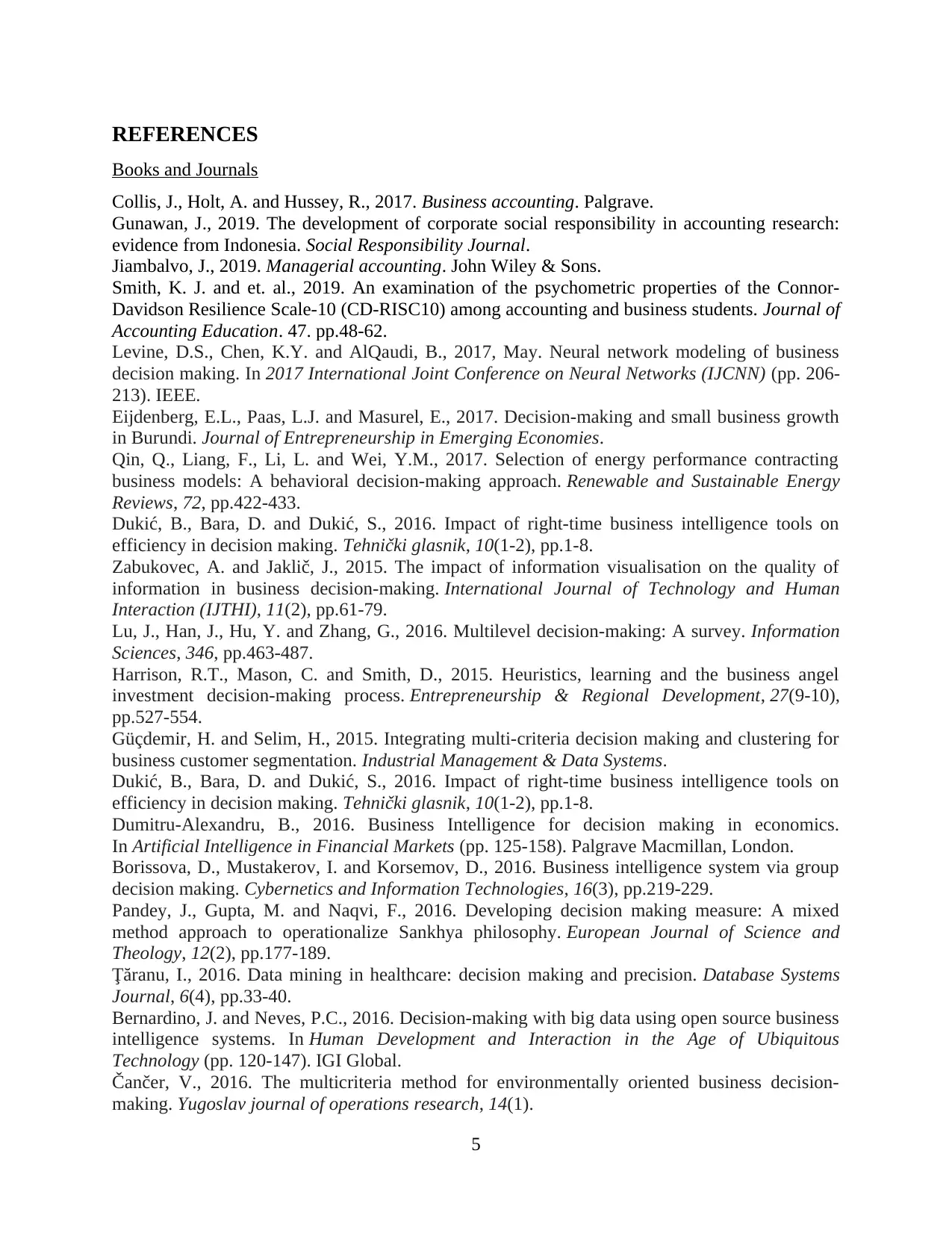
REFERENCES
Books and Journals
Collis, J., Holt, A. and Hussey, R., 2017. Business accounting. Palgrave.
Gunawan, J., 2019. The development of corporate social responsibility in accounting research:
evidence from Indonesia. Social Responsibility Journal.
Jiambalvo, J., 2019. Managerial accounting. John Wiley & Sons.
Smith, K. J. and et. al., 2019. An examination of the psychometric properties of the Connor-
Davidson Resilience Scale-10 (CD-RISC10) among accounting and business students. Journal of
Accounting Education. 47. pp.48-62.
Levine, D.S., Chen, K.Y. and AlQaudi, B., 2017, May. Neural network modeling of business
decision making. In 2017 International Joint Conference on Neural Networks (IJCNN) (pp. 206-
213). IEEE.
Eijdenberg, E.L., Paas, L.J. and Masurel, E., 2017. Decision-making and small business growth
in Burundi. Journal of Entrepreneurship in Emerging Economies.
Qin, Q., Liang, F., Li, L. and Wei, Y.M., 2017. Selection of energy performance contracting
business models: A behavioral decision-making approach. Renewable and Sustainable Energy
Reviews, 72, pp.422-433.
Dukić, B., Bara, D. and Dukić, S., 2016. Impact of right-time business intelligence tools on
efficiency in decision making. Tehnički glasnik, 10(1-2), pp.1-8.
Zabukovec, A. and Jaklič, J., 2015. The impact of information visualisation on the quality of
information in business decision-making. International Journal of Technology and Human
Interaction (IJTHI), 11(2), pp.61-79.
Lu, J., Han, J., Hu, Y. and Zhang, G., 2016. Multilevel decision-making: A survey. Information
Sciences, 346, pp.463-487.
Harrison, R.T., Mason, C. and Smith, D., 2015. Heuristics, learning and the business angel
investment decision-making process. Entrepreneurship & Regional Development, 27(9-10),
pp.527-554.
Güçdemir, H. and Selim, H., 2015. Integrating multi-criteria decision making and clustering for
business customer segmentation. Industrial Management & Data Systems.
Dukić, B., Bara, D. and Dukić, S., 2016. Impact of right-time business intelligence tools on
efficiency in decision making. Tehnički glasnik, 10(1-2), pp.1-8.
Dumitru-Alexandru, B., 2016. Business Intelligence for decision making in economics.
In Artificial Intelligence in Financial Markets (pp. 125-158). Palgrave Macmillan, London.
Borissova, D., Mustakerov, I. and Korsemov, D., 2016. Business intelligence system via group
decision making. Cybernetics and Information Technologies, 16(3), pp.219-229.
Pandey, J., Gupta, M. and Naqvi, F., 2016. Developing decision making measure: A mixed
method approach to operationalize Sankhya philosophy. European Journal of Science and
Theology, 12(2), pp.177-189.
Ţăranu, I., 2016. Data mining in healthcare: decision making and precision. Database Systems
Journal, 6(4), pp.33-40.
Bernardino, J. and Neves, P.C., 2016. Decision-making with big data using open source business
intelligence systems. In Human Development and Interaction in the Age of Ubiquitous
Technology (pp. 120-147). IGI Global.
Čančer, V., 2016. The multicriteria method for environmentally oriented business decision-
making. Yugoslav journal of operations research, 14(1).
5
Books and Journals
Collis, J., Holt, A. and Hussey, R., 2017. Business accounting. Palgrave.
Gunawan, J., 2019. The development of corporate social responsibility in accounting research:
evidence from Indonesia. Social Responsibility Journal.
Jiambalvo, J., 2019. Managerial accounting. John Wiley & Sons.
Smith, K. J. and et. al., 2019. An examination of the psychometric properties of the Connor-
Davidson Resilience Scale-10 (CD-RISC10) among accounting and business students. Journal of
Accounting Education. 47. pp.48-62.
Levine, D.S., Chen, K.Y. and AlQaudi, B., 2017, May. Neural network modeling of business
decision making. In 2017 International Joint Conference on Neural Networks (IJCNN) (pp. 206-
213). IEEE.
Eijdenberg, E.L., Paas, L.J. and Masurel, E., 2017. Decision-making and small business growth
in Burundi. Journal of Entrepreneurship in Emerging Economies.
Qin, Q., Liang, F., Li, L. and Wei, Y.M., 2017. Selection of energy performance contracting
business models: A behavioral decision-making approach. Renewable and Sustainable Energy
Reviews, 72, pp.422-433.
Dukić, B., Bara, D. and Dukić, S., 2016. Impact of right-time business intelligence tools on
efficiency in decision making. Tehnički glasnik, 10(1-2), pp.1-8.
Zabukovec, A. and Jaklič, J., 2015. The impact of information visualisation on the quality of
information in business decision-making. International Journal of Technology and Human
Interaction (IJTHI), 11(2), pp.61-79.
Lu, J., Han, J., Hu, Y. and Zhang, G., 2016. Multilevel decision-making: A survey. Information
Sciences, 346, pp.463-487.
Harrison, R.T., Mason, C. and Smith, D., 2015. Heuristics, learning and the business angel
investment decision-making process. Entrepreneurship & Regional Development, 27(9-10),
pp.527-554.
Güçdemir, H. and Selim, H., 2015. Integrating multi-criteria decision making and clustering for
business customer segmentation. Industrial Management & Data Systems.
Dukić, B., Bara, D. and Dukić, S., 2016. Impact of right-time business intelligence tools on
efficiency in decision making. Tehnički glasnik, 10(1-2), pp.1-8.
Dumitru-Alexandru, B., 2016. Business Intelligence for decision making in economics.
In Artificial Intelligence in Financial Markets (pp. 125-158). Palgrave Macmillan, London.
Borissova, D., Mustakerov, I. and Korsemov, D., 2016. Business intelligence system via group
decision making. Cybernetics and Information Technologies, 16(3), pp.219-229.
Pandey, J., Gupta, M. and Naqvi, F., 2016. Developing decision making measure: A mixed
method approach to operationalize Sankhya philosophy. European Journal of Science and
Theology, 12(2), pp.177-189.
Ţăranu, I., 2016. Data mining in healthcare: decision making and precision. Database Systems
Journal, 6(4), pp.33-40.
Bernardino, J. and Neves, P.C., 2016. Decision-making with big data using open source business
intelligence systems. In Human Development and Interaction in the Age of Ubiquitous
Technology (pp. 120-147). IGI Global.
Čančer, V., 2016. The multicriteria method for environmentally oriented business decision-
making. Yugoslav journal of operations research, 14(1).
5
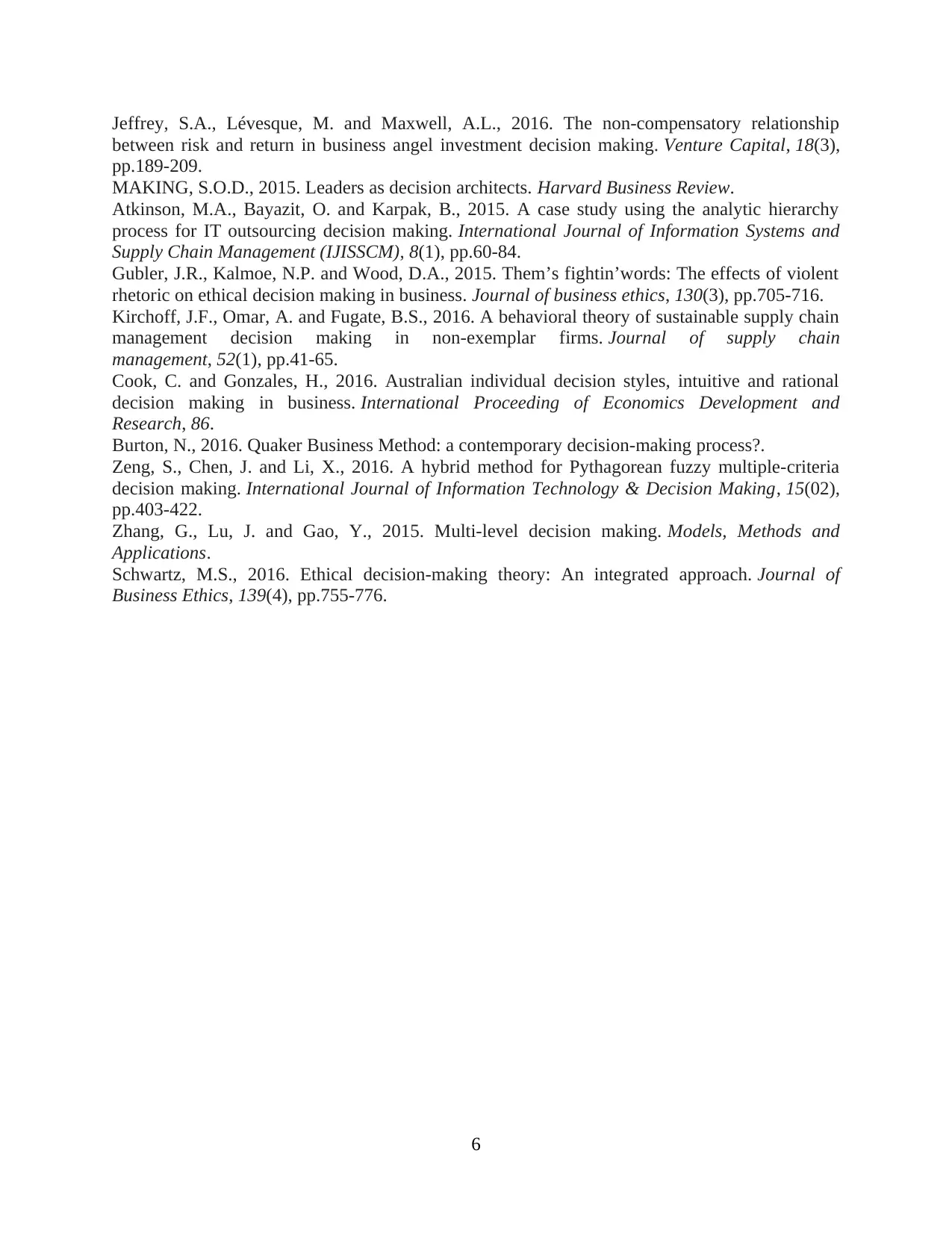
Jeffrey, S.A., Lévesque, M. and Maxwell, A.L., 2016. The non-compensatory relationship
between risk and return in business angel investment decision making. Venture Capital, 18(3),
pp.189-209.
MAKING, S.O.D., 2015. Leaders as decision architects. Harvard Business Review.
Atkinson, M.A., Bayazit, O. and Karpak, B., 2015. A case study using the analytic hierarchy
process for IT outsourcing decision making. International Journal of Information Systems and
Supply Chain Management (IJISSCM), 8(1), pp.60-84.
Gubler, J.R., Kalmoe, N.P. and Wood, D.A., 2015. Them’s fightin’words: The effects of violent
rhetoric on ethical decision making in business. Journal of business ethics, 130(3), pp.705-716.
Kirchoff, J.F., Omar, A. and Fugate, B.S., 2016. A behavioral theory of sustainable supply chain
management decision making in non‐exemplar firms. Journal of supply chain
management, 52(1), pp.41-65.
Cook, C. and Gonzales, H., 2016. Australian individual decision styles, intuitive and rational
decision making in business. International Proceeding of Economics Development and
Research, 86.
Burton, N., 2016. Quaker Business Method: a contemporary decision-making process?.
Zeng, S., Chen, J. and Li, X., 2016. A hybrid method for Pythagorean fuzzy multiple-criteria
decision making. International Journal of Information Technology & Decision Making, 15(02),
pp.403-422.
Zhang, G., Lu, J. and Gao, Y., 2015. Multi-level decision making. Models, Methods and
Applications.
Schwartz, M.S., 2016. Ethical decision-making theory: An integrated approach. Journal of
Business Ethics, 139(4), pp.755-776.
6
between risk and return in business angel investment decision making. Venture Capital, 18(3),
pp.189-209.
MAKING, S.O.D., 2015. Leaders as decision architects. Harvard Business Review.
Atkinson, M.A., Bayazit, O. and Karpak, B., 2015. A case study using the analytic hierarchy
process for IT outsourcing decision making. International Journal of Information Systems and
Supply Chain Management (IJISSCM), 8(1), pp.60-84.
Gubler, J.R., Kalmoe, N.P. and Wood, D.A., 2015. Them’s fightin’words: The effects of violent
rhetoric on ethical decision making in business. Journal of business ethics, 130(3), pp.705-716.
Kirchoff, J.F., Omar, A. and Fugate, B.S., 2016. A behavioral theory of sustainable supply chain
management decision making in non‐exemplar firms. Journal of supply chain
management, 52(1), pp.41-65.
Cook, C. and Gonzales, H., 2016. Australian individual decision styles, intuitive and rational
decision making in business. International Proceeding of Economics Development and
Research, 86.
Burton, N., 2016. Quaker Business Method: a contemporary decision-making process?.
Zeng, S., Chen, J. and Li, X., 2016. A hybrid method for Pythagorean fuzzy multiple-criteria
decision making. International Journal of Information Technology & Decision Making, 15(02),
pp.403-422.
Zhang, G., Lu, J. and Gao, Y., 2015. Multi-level decision making. Models, Methods and
Applications.
Schwartz, M.S., 2016. Ethical decision-making theory: An integrated approach. Journal of
Business Ethics, 139(4), pp.755-776.
6
⊘ This is a preview!⊘
Do you want full access?
Subscribe today to unlock all pages.

Trusted by 1+ million students worldwide
1 out of 9
Related Documents
Your All-in-One AI-Powered Toolkit for Academic Success.
+13062052269
info@desklib.com
Available 24*7 on WhatsApp / Email
![[object Object]](/_next/static/media/star-bottom.7253800d.svg)
Unlock your academic potential
Copyright © 2020–2025 A2Z Services. All Rights Reserved. Developed and managed by ZUCOL.





